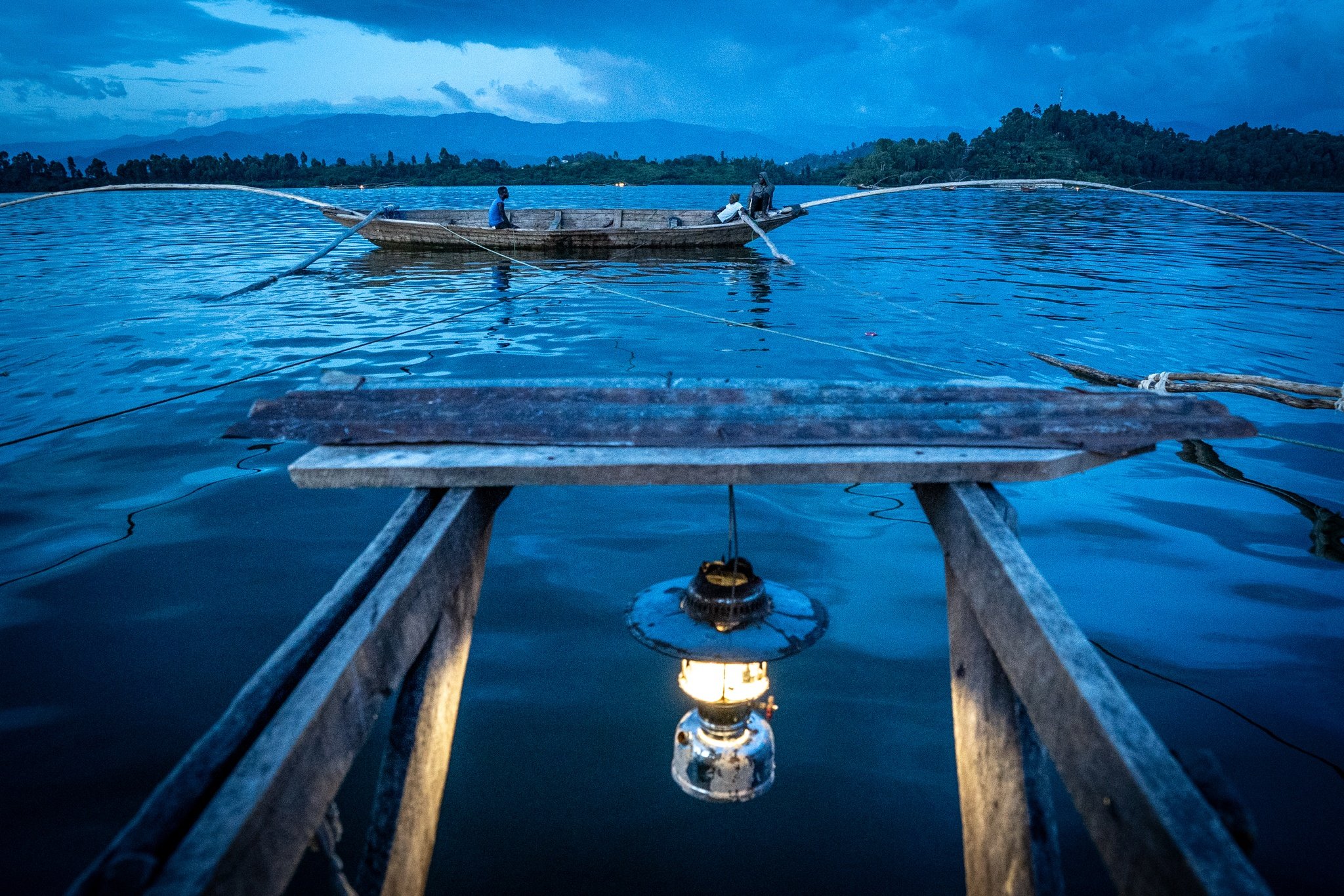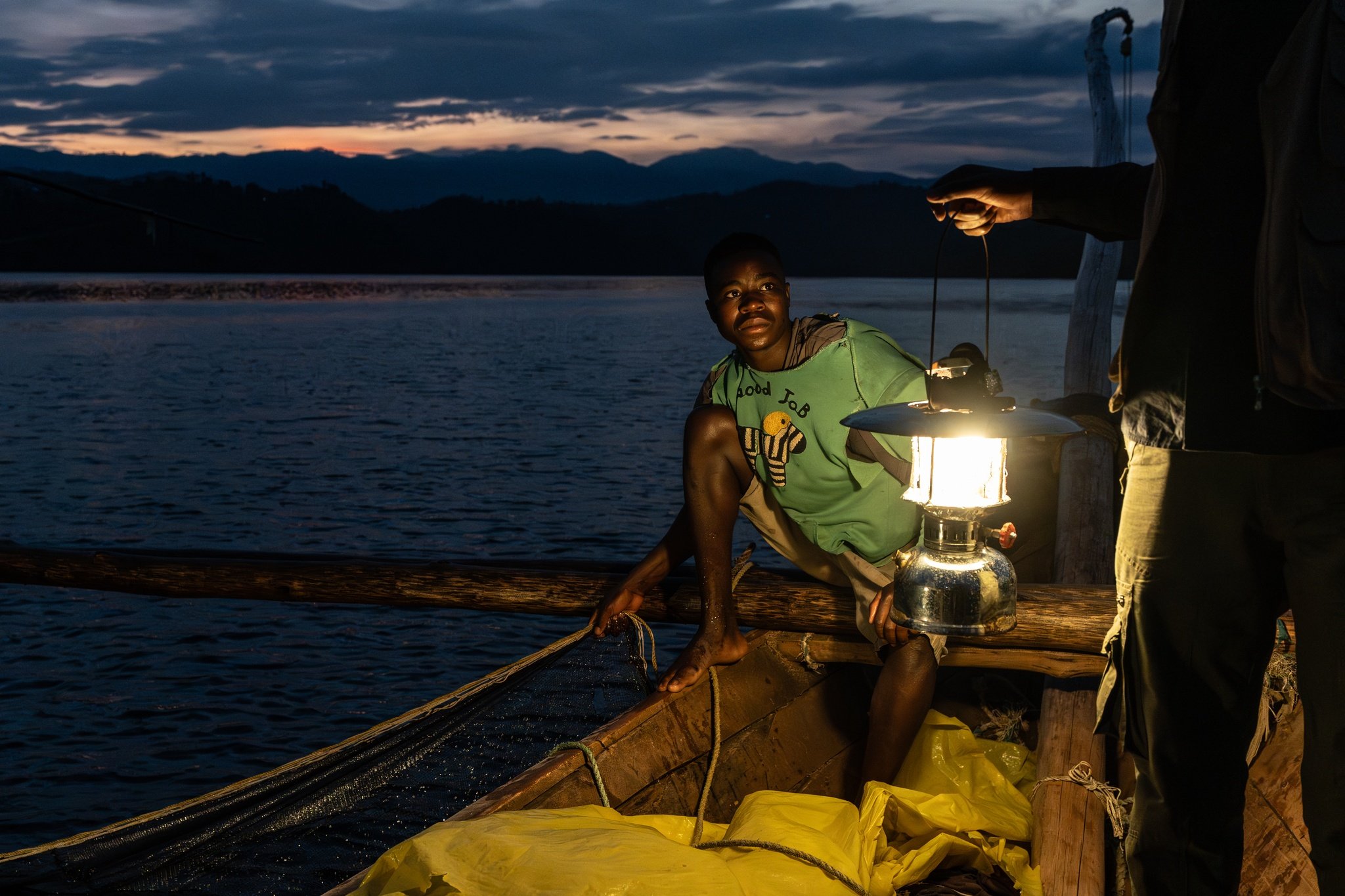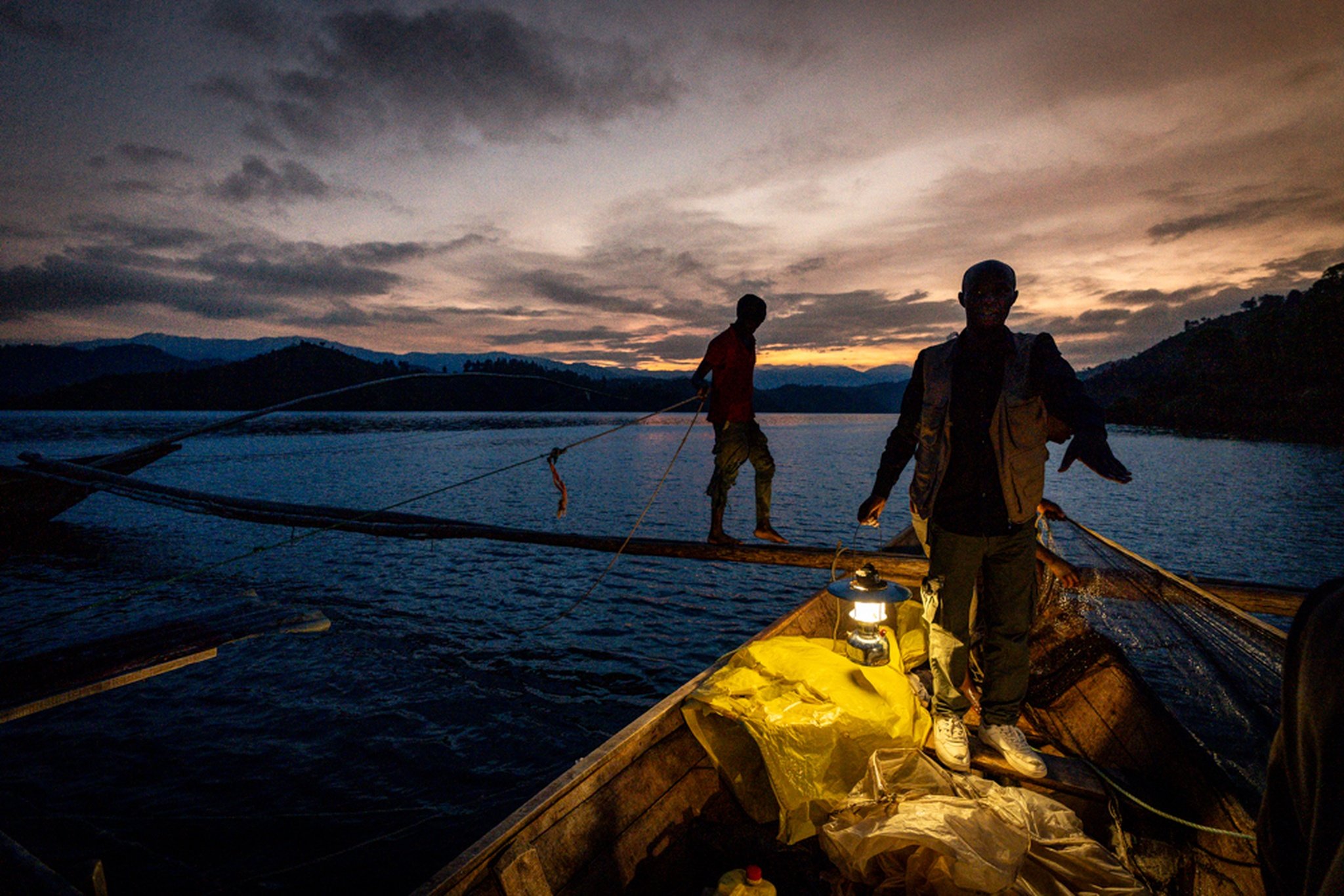Whistle and fish: with Lake Kivu fishermen in Rwanda by Limor Zadok
In the shimmering Lake Kivu in western Rwanda, amidst cracked wooden boats, fishermen whistle while they work. They are known as the "whistling fishermen" and their tradition of singing and whistling to a rhythmic beat synchronized with their rowing movements has been passed down for thousands of years. With the strength of their mountainous arms, they plunge their wooden paddles into the water, splashing them upwards. They remain in the lake throughout the night, folding nets and fish at dawn. To accompany them, I wait at the wooden dock lip for a motorized wooden boat that will take us closer to the fishermen's boats. At four in the morning, the small fishing boats sparkle on the lake with dim lantern light. These flickers of light are crucial for the fishermen as fish are drawn to them and lurk secretly beneath their nets. The lives of the fishermen depend on these flickers of light.
"The moon is too full tonight," said the captain as we boarded his fishing boat. "It's always a disappointing night. The moon robs us of the power of lantern light. On such nights," explained the captain, "we embark on only two fishing trips instead of three. It's hard work for a small amount of fish. The moon blinds and confuses them for us." We accompanied the captain on the grueling night fishing work and experienced several hours of traditional labor that has persisted in this area for thousands of years.
Rowing and whistling
As the sun sets, fishermen set out on traditional night fishing trips in narrow wooden boats with elongated bows, accompanied by enchanting rhythmic singing. We joined the fishermen in the heart of the lake on two occasions: at sunset and as we returned to them in the heart of the night until dawn.
The fishing process involved cooperation between three wooden boats and a team of ten fishermen. It began with a strenuous row from the shores to the center of the lake, with the rowing being synchronized among the fishermen and accompanied by singing, whistling, and splashing water at a steady pace. One team member was responsible for bailing water from the cracked boat floor using a plastic bucket back into the lake.
With the boats stationed in the centre of the lake, the physically challenging task of connecting and tying the heavy fishing nets to wooden stakes connecting the three boats began. After connecting the nets, they spaced the boats apart and doubled the length of the connecting stakes between them. This way, the nets were tensioned in preparation for fishing that took place during the night. In order to attract fish to the nets, the fishermen lit lanterns and hung them on wooden stakes protruding from the boats.
Three fishing rounds take place on the lake every evening and night: at sunset between 18:00 and 21:00, during the night between 23:00 and 3:00 in the morning, and at dawn. After laying out the nets, the fishermen sleep except for the Captain who remains awake all night, refreshing the lantern light every quarter hour and extending the lifespan of the light.
On a full moon night, the fishermen go out for only two fishing rounds. As we returned and joined the fishermen's boats in the darkness of the night to accompany their work towards dawn, small glimmers of lantern from fireflies painted ribbons of light across the surface of the lake. With the first light of dawn, the fishermen stirred from their slumber. The captain began collecting the fireflies hanging above the nets, placing them into the central pot and extinguishing them. The fishermen lined up on wooden stools and started pulling up the heavy, wet fishing nets, a task that continued for over an hour, requiring strenuous physical labor. Only five kilograms of fish were yielded by ten fishermen during that night's work. Their wage for a hard night's work amounted to only one dollar each, half the wage of the international poverty line, which stands at two dollars per day. As the fish collection process began, a festive flock of dragonflies, fish, and waterfowl danced above them. The fishermen didn't struggle with them since each of them had a place within the living ecology of Lake Kivu.
Each fisherman was allowed to take only a handful of sardines for himself, only what he managed to cram into the palm of his hand. They placed their handful of sardines in a corner of their wooden boat, which was their personal nightly harvest with which they would return home. With this handful of sardines, they would feed their children and families.
Lake Kivu - Nice to meet
Lake Kivu is situated between Rwanda and the Democratic Republic of Congo, in western Rwanda, at an altitude of approximately 1460 meters. It is surrounded by lush hills, and its freshwaters are dotted with small islands, which are home to wild cattle. These cattle swim from one island to another as soon as the pasture on one island dwindles. Lake Kivu is one of the largest lakes in the East African Lakes system, covering an area of 2700 km². It was formed within the rift valley in the southern part of the Syrian African rift. The most famous of these lakes is Lake Victoria, which is considered the source of the White Nile. The lake provides drinking water, irrigation water, and fish for approximately two million people living alongside it. There are traditional fishing villages, agricultural villages, and several towns around the lake. Thousands of residents make a living as traditional fishermen, using wooden boats and nets, a livelihood that has remained unchanged for thousands of years and is passed down from generation to generation. In the past, children as young as ten became fishermen and were not sent to school because their future was to become fishermen, and they were required to focus solely on that. Today, the government restricts their entry into fishing work until the age of sixteen. The fish population in Lake Kivu consists of a small variety of freshwater fish, including tilapia, carp species, catfish, and sardines, which were introduced specifically to the lake in the 1950s. The annual fish catch stands at about 21,400 tons, which is the largest of all East African lakes. To preserve the fish in the lake, fishermen take five days off every month and take two months of recess each year. However, during these periods, they do not earn any income.
A peaceful lake, on its surface, which conceals a ticking time bomb
Lake Kivu is a beautiful place, but it has a hidden danger. The lake contains a lot of gases like carbon dioxide and methane, which are dangerous to humans and the environment. These gases have built up at the bottom of the lake due to volcanic activity. They are trapped in the lower layers of water because of differences in salinity. The gases are not released into the air because of the stable structure of the lake water layers. However, if the water layers mix, it could lead to a massive explosion. The active volcanoes near the northern part of the lake could cause this to happen. It is important to keep this in mind to protect the residents of the area and the environment.
This phenomenon, known as "lake overturn," has only been observed twice in history. The most recent case occurred in Cameroon forty years ago. In a tragic event, one morning, 1,700 residents who lived near Lake Nyos were discovered dead. It took time to determine the cause of their death. The haze surrounding the lake was actually a transparent, odourless "blanket" of hundreds of thousands of tons of carbon dioxide emitted from the bottom of the "exploding lake," which caused the suffocation of the residents. The eruption also created a tsunami wave that reached a height of 24 meters. Another lake similar to Lake Nyos is found in Italy - Lake Albano. In Cameroon, a complex pumping system was installed in Lake Nyos and the nearby Monoun Lake to extract the dissolved carbon dioxide, making them completely safe lakes. However, this solution is not feasible for Lake Kivu due to the complexity of extracting gases from it.
Fishing work was historically assigned to men, but since the Rwandan genocide in 1994, the situation has changed. Ninety per cent of Tutsi males in the Lake Kivu area were murdered during the genocide, which became one of the darkest chapters in modern history. Around 70% of the population in the region are women now, who have been compelled to take up fishing in order to provide for their families. Every day, groups of women gather at the shores early in the morning. They spend 48 hours drying the fish, which they then distribute in buckets and bags throughout the country, selling them in markets.
Limor Zadok is a phototherapist, Lacanian psychoanalyst, and movement, expression, and creation therapist. She is also an experienced photographer and tour guide who specializes in Southeast Asia tours, having done so since 1991.
At 50, I fell in love with photography, integrating my passions for psychic life and world cultures. My work centers around street, documentary, and cultural photography, capturing the story and cultural context of my subjects. During the pandemic, I started a venture connecting cultural research and geography, hosting workshops in Bedouin communities, meeting with Sufis and Circassians, and visiting Druze villages. When possible, we plan to guide abroad with an emphasis on Southeast Asia.



























































